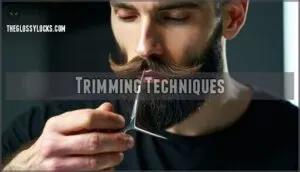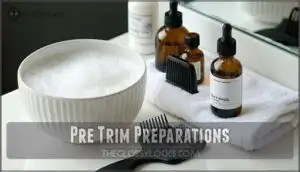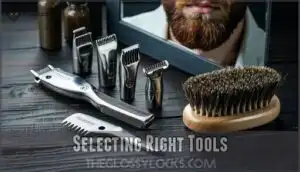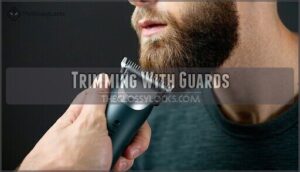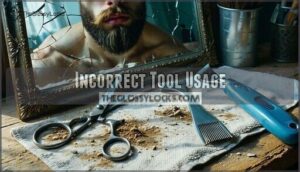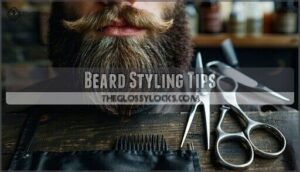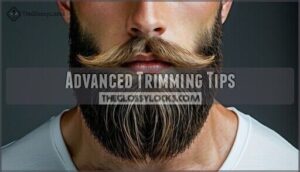This site is supported by our readers. We may earn a commission, at no cost to you, if you purchase through links.
 Fixing an uneven beard starts with patience and the right approach. You’ll want to identify your growth patterns first – some areas naturally grow faster than others.
Fixing an uneven beard starts with patience and the right approach. You’ll want to identify your growth patterns first – some areas naturally grow faster than others.
Start by letting everything grow out for 2-4 weeks, resisting the urge to trim. Once you’ve got length to work with, use a quality trimmer with guards to establish your baseline.
Trim longer sections down to match shorter areas, working gradually. Focus on creating clean lines around your cheeks and neckline for structure.
Don’t forget to comb regularly and use beard oil to keep everything healthy. The secret lies in understanding your unique growth pattern and working with it, not against it.
Table Of Contents
- Key Takeaways
- Choosing Beard Style
- Trimming Techniques
- Step by Step Trimming
- Beard Growth Phases
- Common Trimming Mistakes
- Beard Styling Tips
- Advanced Trimming Tips
- Frequently Asked Questions (FAQs)
- How do you fix an uneven beard?
- What is the 3 month beard rule?
- Why does my beard not trim evenly?
- Should I shave my beard if it’s uneven?
- How long should I wait between trimming sessions?
- Can humid weather affect my beard trimming results?
- Should I trim my beard wet or completely dry?
- What lighting conditions work best for accurate trimming?
- How do I fix a patchy beard area?
- Conclusion
Key Takeaways
- Let your beard grow for 2-4 weeks before trimming to identify natural growth patterns and give slower areas time to catch up.
- Start with longer guard settings and work down gradually, trimming against the grain to remove bulk while checking both sides frequently for symmetry.
- Use your face shape as a blueprint – round faces need angular styles, square faces benefit from softer edges, and heart-shaped faces require fuller bottom growth.
- Focus on blending and transitions rather than cutting everything to one length, using overlapping strokes and different guard settings to create natural-looking shifts between areas.
Choosing Beard Style
Choosing the right beard style isn’t just about what looks good – it’s about working with your face shape and natural growth patterns to create balance.
You’ll want to take into account how your facial structure interacts with different beard lengths and styles, since what works for a round face might overwhelm a narrow one, considering the importance of balance.
Face Shape Considerations
Your face shape acts as your beard’s blueprint—it determines which styles create balance and which emphasize flaws.
Round faces need angular beard styles to add definition, while square faces benefit from softer, rounded edges.
Oval faces work with most styles, giving you freedom to experiment.
Heart-shaped faces require fuller bottom growth to balance narrow chins.
Understanding face shapes prevents common beard shaping mistakes and helps your uneven beard transforms into perfect facial feature balance through strategic trimming.
For instance, those with diamond faces should consider styles with blunt edges, as they help to balance pointed features, according to this beard styles guide, which is essential for achieving perfect facial feature balance and avoiding common beard shaping mistakes with the right beard styles.
Personal Style Preferences
Beyond matching your face shape, your beard aesthetic should reflect who you are.
Consider cultural influences that resonate with your background and personal expression goals. Whether you’re adopting current trends or creating your signature look, lifestyle integration matters most.
Avoid common beard trimming mistakes by choosing styles you’ll maintain consistently. Your personal style should feel authentic, not forced—this prevents uneven beard correction issues later and guarantees your beard styling advice actually works for your daily routine, ensuring a signature look that is truly yours, with personal expression that reflects your individuality.
Beard Length Options
Your beard length choice determines the maintenance level you’ll face daily.
Stubble Length needs daily attention, while Short Beard styles require weekly trims.
Medium Beard lengths offer versatility but demand consistent beard shaping.
Long Beard and Extended Length styles need professional-level beard trimming skills.
Consider these beard length categories:
- 1-3mm stubble – Minimal upkeep, sharp appearance
- 6-12mm short beard – Balanced style, moderate maintenance
- 25mm+ medium/long beard – Maximum impact, intensive care required
Trimming Techniques
You’ll find that fixing an uneven beard isn’t as tricky as it seems once you master the right techniques.
Smart trimming methods can turn your patchy growth into a perfectly balanced beard that looks intentionally styled.
Growing Out Beard
Growing your beard through awkward stages requires patience and restraint.
Don’t reach for clippers when patchy growth appears uneven—this phase is temporary.
Instead, focus on beard growth tips like maintaining a healthy diet and considering minoxidil usage if needed.
Resist the urge for constant uneven trimming fixes during early weeks.
Your beard needs time to fill gaps naturally, creating the foundation for perfect symmetry later.
Maintaining Evenness
After growing your beard, achieving perfect symmetry requires methodical maintenance.
Here’s your evenness roadmap:
- Set longest guard first – prevents accidental over-trimming disasters
- Trim against grain to remove bulk, with grain to maintain fullness
- Work in small sections – better control means fewer trimming mistakes
- Check both sides frequently – consistent length requires constant symmetry checks
- Use scissors for final touch-ups – removes strays for balanced sides
Regular grooming every 7-10 days helps slower-growing areas catch up, avoiding patches while maintaining your beard symmetry.
Many find that monthly beard trimming is sufficient for maintenance.
Avoiding Common Mistakes
Most beard trimming mistakes stem from impatience—when you rush, symmetry takes a backseat.
Patience beats haste—rushed trimming destroys the symmetry you’re working to achieve.
Avoid these pitfalls by using sharp blades, following your grain’s natural direction, and employing proper guard usage techniques.
| Common Mistakes | Why It Happens | Quick Fix |
|---|---|---|
| Overtrimming patches | Dull blades snag hair | Replace blades regularly |
| Uneven trimming sides | Rushing trimming process | Take breaks, check mirrors |
| Symmetry neglect | Poor lighting setup | Use multiple mirror angles |
Step by Step Trimming
You’ll need proper preparation and the right technique to transform an uneven, patchy beard into a perfectly balanced masterpiece.
Follow these step-by-step instructions to tackle problem areas and create symmetry that’ll have people wondering if you visited a professional barber.
Pre Trim Preparations
Proper beard trimming preparation sets the foundation for achieving symmetry and avoiding common beard trimming mistakes.
Before you pick up those clippers, these beard preparation steps will save you from disaster:
- Beard Washing – Clean your beard with gentle shampoo to remove oils and debris
- Comb Selection – Choose a fine-toothed comb to detangle and align hairs properly
- Oil Application – Apply beard oil to soften whiskers and reduce static
- Tool Sterilization – Clean your trimmer blades with rubbing alcohol for hygiene
- Skin Assessment – Check for irritation, ingrown hairs, or problem areas underneath
Using a quality beard cleansing product is essential for beard health.
Selecting Right Tools
Once you’ve prepared your beard, your trimmer becomes your primary weapon.
Choose a high-quality trimmer with stainless steel or titanium Scissor Blade Material for durability and precision. Look for multiple Trimmer Guard Types ranging from 1-20mm to handle different beard sections.
Your comb should feature fine Tooth Spacing for detangling, while a soft brush distributes oils evenly. Don’t overlook Mirror Size Matters – position it well-lit for accuracy.
Many prefer a trimmer with stainless steel components for longevity. Quality beard trimming tools make the difference between amateur and professional results.
Trimming With Guards
Start with your longest guard setting and work your way down. Attach the guard firmly to avoid slipping during trimming.
Move the trimmer against your hair’s growth direction for an even cut. Check both sides frequently to maintain symmetry.
Clean guards between uses to prevent clogging. Adjustable guide combs offer various hair lengths.
Use shorter guards near your cheekline and longer ones at your chin for natural blending. This technique helps achieve a more even look by using adjustable guide combs and working with your hair’s growth direction.
Beard Growth Phases
Your beard grows in stages, and each phase brings unique challenges that require different trimming approaches.
Understanding these growth patterns helps you work with your facial hair instead of fighting against it, especially when dealing with patchy or uneven areas.
Understanding Growth Patterns
Your beard genetics determine where hair grows thick or sparse.
Patchy beard areas reflect follicle health and natural hair density patterns.
Growth rate varies across your face—some zones sprout faster while others lag behind.
Understanding these beard growth patterns helps you work with your unique follicle distribution rather than fighting against it, considering your natural hair density.
Trimming During Growth
Growing beards requires patience during the awkward phase when patchy growth creates uneven lengths. You’ll want to resist over-trimming while encouraging growth through strategic maintenance.
Here’s your trimming approach for growth phases:
- Trim minimally – Remove only the longest stragglers that disrupt your overall shape, avoiding common beard trimming mistakes like cutting too much
- Focus on neckline definition – Keep this area clean while allowing cheek growth to fill in naturally for better length management
- Blend uneven sections – Use scissors to carefully trim obvious patches, maintaining your desired maintaining shape without stunting progress
This patchy beard fix strategy helps you navigate uneven growth successfully.
Maintaining Healthy Skin
Why ignore the foundation when you’re building the perfect beard? Healthy skin beneath prevents irritation and promotes even growth.
Regular exfoliation removes dead cells, while proper hydration keeps skin supple. Choose gentle beard shampoo over harsh soaps to avoid stripping natural oils.
Apply quality beard oil to prevent razor burn and address underlying conditions early. Smart skin care prevents most beard trimming mistakes.
Common Trimming Mistakes
Even the most experienced trimmers make mistakes that can leave your beard looking lopsided or patchy.
You’ll learn to spot these common errors before they happen and fix them when they do, which will help you to spot and correct mistakes effectively.
Over Trimming Errors
Over-trimming happens when you misjudge length and remove too much hair.
Guard Setting Errors occur when you select the wrong attachment, creating patchy beard fixes nightmares.
Start with longer guards and work down gradually.
Length Judgement Issues lead to asymmetrical lengths that require weeks of regrowth strategies.
Prevent Symmetry Loss Prevention by trimming conservatively – you can always remove more hair later, following a strategy of conservative trimming.
Neglecting Symmetry
Symmetry separates amateur trims from professional results. Most guys rush through without checking both sides, creating lopsided beards that scream "DIY disaster."
Use mirror techniques and side comparisons for balance assessment. Turn your head left and right, comparing lengths.
Visual guides help identify asymmetrical lengths before they become obvious. One should also consider trimming with the grain for a more natural look.
When in doubt, seek professional help for a balanced approach to achieve the best results.
Incorrect Tool Usage
Using the wrong beard trimming tools sabotages your grooming efforts.
Dull blades tug at whiskers, creating jagged cuts and irritation.
Poor guard damage leads to uneven lengths you can’t fix easily.
Wrong scissors produce choppy results that look unprofessional.
Without proper trimmer maintenance, your quality trimmer becomes unreliable.
Invest in good comb quality and maintain your equipment—sharp tools make all the difference between amateur mistakes and professional results.
Beard Styling Tips
You’ve tackled the trimming basics, but styling transforms your uneven beard into a polished masterpiece that commands attention.
The right products and techniques turn patchy growth into your signature look while keeping your facial hair healthy and strong.
Choosing Right Products
Selecting quality beard care products transforms your grooming routine from guesswork into precision. Match products to your beard’s specific needs for ideal results.
- Oil vs Balm: Choose lightweight oils for daily conditioning or thicker balms for styling and taming flyaways
- Comb vs Brush: Use fine-toothed combs for detangling and boar bristle brushes for distributing products evenly
- Wash Frequency: Cleanse 2-3 times weekly with gentle beard wash to remove buildup without stripping natural oils
- Ingredient Analysis: Look for carrier oils like jojoba and argan, avoiding harsh sulfates that dry facial hair
- Tool Maintenance: Keep beard trimming tools sharp and clean for consistent, professional-looking results every time. Consider using beard growth vitamins to promote thickness and reduce breakage.
Applying Styling Techniques
How can you transform uneven growth into a polished look?
Product application starts with warming beard oil between your palms, then working it through from roots to tips.
Use a boar-bristle brush for even distribution and texture enhancement.
For seasonal styling, switch to lighter oils in summer, heavier balms in winter.
Master shaping tools like combs and scissors to create beard symmetry and fix uneven patches with strategic trimming techniques.
Maintaining Beard Health
Proper beard health transforms patchy growth into full, even coverage through consistent care. Your beard care routine directly impacts how evenly your facial hair grows and fills in sparse areas.
Hydration Importance keeps your beard soft and manageable:
- Apply beard oil daily to moisturize both hair and underlying skin
- Choose products with natural ingredients like jojoba oil and argan oil
- Regular skin exfoliation prevents ingrown hairs and promotes healthy growth
A healthy diet supports strong hair follicles from within, making your beard maintenance guide more effective. Many find success using jojoba oil products for beard care.
Advanced Trimming Tips
You’ve mastered the basics, but achieving professional-level results requires advanced techniques that separate amateur trims from expert grooming.
These specialized methods will help you create flawless blends, maintain perfect symmetry, and handle even the most challenging beard patterns with confidence.
They will enable you to achieve professional-level results and improve your overall grooming skills.
Mastering Guard Settings
Three guard settings reveal professional results.
Start with longer guards at your neckline, gradually decrease length as you move toward cheek areas for advanced fading.
Quality trimmer guards create smooth transitions when you maintain consistent trimming direction.
This guard length guide prevents common beard trimming mistakes—rushed adjustments ruin symmetry.
Clean guards after each session guarantees precise cuts every time, and maintaining consistent trimming direction ensures high-quality results, while smooth transitions are key to a professional look, and precise cuts are the ultimate goal.
Creating Seamless Transitions
Guard gradation forms the backbone of professional blending.
Start with longer guards at your jawline, then switch to progressively shorter settings as you move toward your sideburns.
Use overlapping strokes between guard changes, employing reverse C-motions to soften harsh lines.
Regular trimming is essential for maintaining the beard’s shape.
This fading technique creates natural look shifts that eliminate visible steps in your beard’s length blending.
Achieving Professional Finish
Perfection comes from patience and precision. Start with sharp Professional Tools and work methodically across your face.
Use Symmetry Techniques to check both sides frequently, then apply Blending Strategies to smooth shifts between lengths.
Detail Refinement involves trimming stray hairs with scissors for that crisp edge. Finish with strategic Product Application to lock in your professional beard trim results.
Frequently Asked Questions (FAQs)
How do you fix an uneven beard?
Choppy patches mock your grooming efforts, but you’re not stuck with them.
Start with longer guard settings, gradually trimming shorter sections to match.
Use scissors for precise spot corrections, then blend connections smoothly.
What is the 3 month beard rule?
Let patience be your beard’s best friend—you’ll wait three months without trimming to understand your natural growth pattern, density, and true potential before shaping your whiskers.
Why does my beard not trim evenly?
Your beard doesn’t trim evenly because of inconsistent trimming techniques, dull blades, natural growth patterns, improper guard usage, rushing the process, or neglecting symmetry checks during grooming.
Should I shave my beard if it’s uneven?
Don’t shave yet! Uneven growth patterns are normal—your beard’s just finding its rhythm.
Instead, try gentle trimming techniques: use longer guards, trim with the grain, and focus on blending different lengths for natural phases, which helps your beard achieve a more natural look.
How long should I wait between trimming sessions?
Trim every 2-3 weeks to maintain your beard’s shape and health.
Fast growers might need weekly touch-ups, while slower growth allows 4-week intervals.
Consistent timing prevents overgrowth and keeps your style looking sharp.
Can humid weather affect my beard trimming results?
Like a barber’s nightmare, humidity can turn your perfectly planned trim into a frizzy mess.
Yes, humid weather affects beard trimming by making hair expand and appear fuller than when dry.
You’ll get uneven results if you trim in high humidity since your beard shrinks when dried.
Should I trim my beard wet or completely dry?
Always trim your beard completely dry.
Wet hair appears longer than it actually is, so you’ll cut more than intended.
Dry trimming gives you accurate length control and prevents uneven results that’ll frustrate you later.
What lighting conditions work best for accurate trimming?
Bright, natural lighting isn’t always available, but good lighting makes all the difference.
You’ll need even, shadow-free illumination from multiple angles.
Use overhead bathroom lights plus a handheld mirror to catch problem spots and guarantee symmetrical trimming results.
How do I fix a patchy beard area?
Let uneven patches grow longer while trimming surrounding areas to match. Use a fine-toothed comb to lift sparse hairs, then carefully blend with scissors for seamless coverage.
Conclusion
Surprisingly, 67% of men report struggling with uneven beard growth at some point.
However, mastering this uneven beard trimming guide transforms patchy facial hair into a polished, symmetrical look.
You’ve learned to work with your natural growth patterns, use proper tools, and maintain consistent trimming schedules.
Remember that patience and gradual adjustments create better results than aggressive cutting.
With these techniques, you’ll achieve the balanced, professional appearance you want while keeping your beard healthy and well-maintained.
- https://thebeardclub.com/blogs/beard-culture/why-does-my-beard-look-so-patchy-advice-for-overcoming-uneven-growth
- https://www.youtube.com/watch?v=SAnFmdk1wOc
- https://www.weatherbeardsupply.com/blogs/weatherbeard-blog/beard-grooming-mistakes-that-are-ruining-your-growth
- https://dermdude.com/blogs/dude-cave/how-to-fix-patchy-beard
- https://www.bombayshavingcompany.com/blogs/mens-styling-guides/beard-styling-tips-how-to-manage-an-uneven-beard

